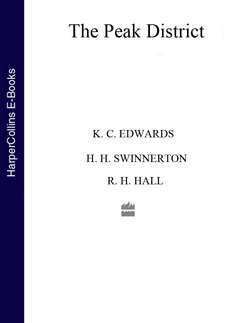Collins New Naturalist Library

Реклама. ООО «ЛитРес», ИНН: 7719571260.
Оглавление
K. Edwards C.. Collins New Naturalist Library
COPYRIGHT
CONTENTS
PLATES IN COLOUR
PLATES IN BLACK AND WHITE
MAPS AND DIAGRAMS
EDITORS’ PREFACE
AUTHOR’S PREFACE
CHAPTER 1. INTRODUCTORY: THE FIRST NATIONAL PARK
CHAPTER 2. THE ROCKS AND THEIR HISTORY
CHAPTER 3. THE MAKING OF THE SCENERY
CHAPTER 4. CLIMATE AND SOILS
CHAPTER 5. THE FOREST
CHAPTER 6. THE MAJOR PLANT ASSOCIATIONS
CHAPTER 7. FLOWERLESS PLANTS
CHAPTER 8. EARLY MAN IN THE PEAK
CHAPTER 9. VILLAGES AND FARMS
CHAPTER 10. PEAKLAND TOWNS AND ROUTES
CHAPTER 11. PLOUGHLAND AND PASTURE
CHAPTER 12. WEALTH FROM THE ROCKS
CHAPTER 13. WATER FOR CITIES
CHAPTER 14. MILLS AND FACTORIES
CHAPTER 15. THE PEAK AS A NATIONAL PARK
PICTURE SECTION
APPENDIX I. NOTE ON BIRD LIFE IN THE PEAK DISTRICT
APPENDIX II. NOTE ON FISH LIFE IN THE PEAK DISTRICT STREAMS
APPENDIX III. NATURE CONSERVATION SITES1
APPENDIX IV. PRINCIPAL RAMBLERS’ CLUBS
FOOTNOTES. CHAPTER 6: THE MAJOR PLANT ASSOCIATIONS
CHAPTER 7: FLOWERLESS PLANTS
APPENDIX III: NATURE CONSERVATION SITES
If you enjoyed The Peak District, check out these other great New Naturalist titles
Отрывок из книги
James Fisher, M.A.
John Gilmour, M.A., V.M.H.
.....
Far away on the distant mountains, during rainy seasons, the rivers became swollen into flood. Their waters spread on the plains as shallow transitory lakes and deposited their sand and mud in thin sheets everywhere. Sometimes the flood-waters found their way into and replenished the more permanent lakes. When the dry season set in and the floods ceased the temporary lakes were dried up and the permanent were reduced by intense evaporation. In both cases the salts that were in solution were left behind. The lakes consequently became more and more salty until such minerals as calcium sulphate and sodium chloride were precipitated. In modern times these chemical deposits have been exploited for gypsum and alabaster in south Derbyshire and for salt in Cheshire.
At last this arid period known as the Triassic drew to a close. Its plains began to subside, were carried down below sea-level so that these too became submerged. This event ushered in the second division of the Mesozoic Era, known as the Jurassic Period. At first this new sea tended to be muddy but later its waters were often clear during long stretches of time and then limy deposits were laid down. The latter contained numerous small round pellets resembling the roe of fishes. For this reason the rocks formed from these deposits are known as Oolitic Limestones (oos=egg).
.....